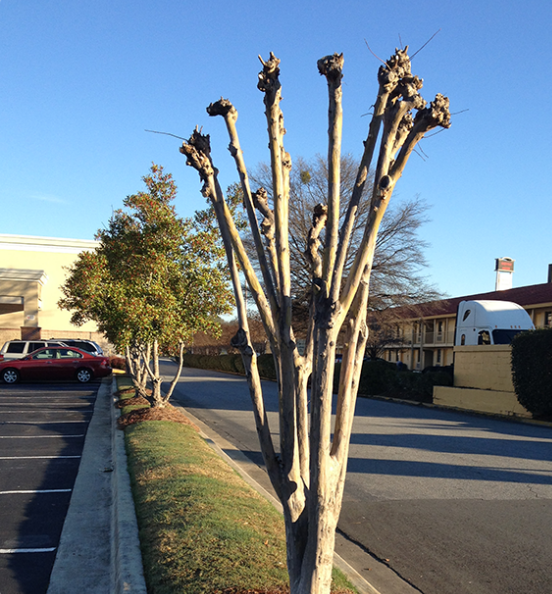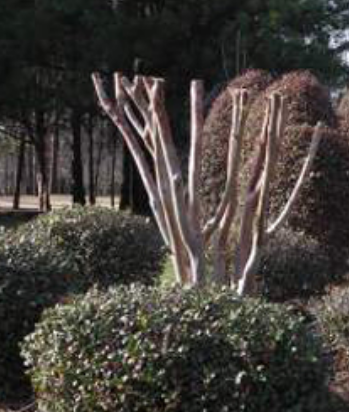Crape Myrtle Care Specialist
Crape Myrtle Care Specialists - Because “Crape Murder” Isn’t an Option
The thinking that Crape Myrtles should be pruned back heavily or they won’t bloom, is a total myth. This bad pruning practice actually does severe damage to the tree. Call us for selective hand pruning to maintain your crape myrtle’s beauty and shape.
🌸 About Crape Myrtles


Known for their vibrant summer blooms, smooth multi-toned bark, and elegant branching, crape myrtles (Lagerstroemia) are a favorite ornamental tree throughout Rock Hill and the Southeast. These hardy, sun-loving trees thrive in warm climates and are prized for their long flowering season, typically from mid-summer through early fall.
Crape myrtles come in a wide variety of sizes, colors, and cultivars—from dwarf shrubs to towering 20-foot trees. Their natural form is open, vase-like, and sculptural when allowed to grow without aggressive pruning. With proper care and placement, crape myrtles require minimal maintenance and can provide beauty and seasonal interest for decades.
As specialists in crape myrtle care, we ensure your trees maintain their natural shape, vibrant blooms, and long-term health through thoughtful pruning and proactive care.
Crape Murder
Crape murder refers to the all-too-common practice of cutting off the tops of the trees. This type of pruning know as hat-racking or heading and severely impacts the appearance of this beautiful tree. This severe pruning reduces its leaf-producing surfaces. Plants need leaves to produce food, so these plants are forced to use precious stored food to develop an entirely new canopy every summer. This misunderstood practice of topping can damage the trees and could reduce their life expectancy.
Please don’t murder your crapes! Call us for selective hand pruning to maintain the beauty and shape.
Cutting it back to thick stubs each year destroys it structure and form. The graceful, free flowing tree quickly becomes a fencepost or hat rack. The pretty bark never appears and each beheaded trunk grows a Medusa-like tangle of spindly whips too weak to hold up flowers.
Once this pollarding practice has begun, it will take several years, if ever, to get this once beautiful tree back to “normal.”
The only pruning crape myrtles require is the thinning on young trees leaving somewhere around 3 to 5 permanents trunks. In the early spring, remove any new suckers that may appear. As the tree matures, removing crossing or rubbing branches will promote a more defined and healthier tree.
Objectives of Pruning Crape Myrtles
Crape Myrtles bloom on the current season’s growth in mid-Summer, so pruning can be completed in late Fall to early Spring and still flower normally throughout the summer.
If the Crape Myrtle was correctly planted for its size and shape, it will grow naturally with only minor pruning required.
The objectives of pruning a crape myrtle are to maintain its natural sculptural form, produce strong branches that hold flowers upright, and open in its center to reveal the smooth, multi-toned bark that forms on mature trunks and branches.
When To Prune Crape Myrtle
Crape myrtles bloom on new growth, making late winter to early spring the ideal time for pruning. This timing allows for:
- Healthy Regeneration: Encouraging robust new shoots for the upcoming bloom season.
- Disease Prevention: Minimizing the risk of infections during active growth periods.
- Enhanced Bloom Production: Stimulating more prolific and vibrant flowering.

Comprehensive Crape Myrtle Care Services
Beyond pruning, we offer a full suite of services to ensure your crape myrtles remain healthy and beautiful:
- Soil Assessment: Evaluating and amending soil conditions for optimal growth.
- Pest and Disease Management: Identifying and treating common issues like aphids and powdery mildew.
- Fertilization Plans: Providing tailored nutrient regimens to support vigorous growth and flowering.
Schedule Your Consultation Today
Ready to give your crape myrtles the care they deserve? Contact Niwaki Tree and Shrub Care for a personalized consultation and discover how our expertise can enhance your landscape.

Crape Myrtle Care FAQ
Lack of blooms can be caused by several factors including too much shade, improper pruning, late-season fertilization, or cold weather damage. Crape myrtles need full sun (at least 6 hours per day) and bloom on new growth—so pruning too late in spring or over-fertilizing can reduce flowering.
Crape myrtle bark scale won’t typically kill the tree, but it can severely impact its health, vigor, and blooming potential. This invasive insect creates a black, sooty mold and feeds on sap. Early treatment with horticultural oils or systemic insecticides can help control the infestation and restore tree health.
Crape myrtles are considered moderate to fast growers, typically gaining 1 to 2 feet in height per year under ideal conditions. Growth rates vary depending on the variety, soil quality, sunlight exposure, and pruning practices.
Yes, but recovery takes time. Gradual, corrective pruning and proper care can help restore a tree’s natural structure and blooming ability over several seasons.
While not mandatory, annual pruning helps maintain the tree’s shape, health, and flowering potential.



